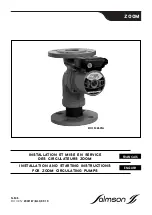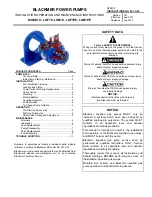
6
Problem
Probable Cause
Remedy
Motor current draw is
excessive.
Noisy pump operation
Pump fails to maintaining
pressure.
Low oil output.
Pump builds pressure
slowly or erratically.
Defective motor.
By-pass valve malfunction.
Damaged or worn piston.
Piston block piston sticking. Springs
or balls damaged, or missing
springs.
Oil leaking from one or more
components within the reservoir.
Pump component parts leaking.
By-pass valve may be
malfunctioning.
Oil intake screens on piston blocks
may be clogged with debris.
Low oil level.
Internal leakage in valve.
Remove the motor. Test and replace if
necessary.
Inspect and test the by-pass valve if required.
Valve is preset. If damaged or incorrectly set,
replace.
Test and inspect the piston blocks. Replace if
necessary.
Remove the piston blocks. Inspect and replace
as required. Each piston block is non-
serviceable.
Remove the pump from the reservoir and
perform the back pressure test. Contact
Enerpac for test procedure.
Perform the back pressure test to isolate leaks.
Test and inspect by-pass valve. Replace and
set if necessary.
Inspect intake screens. Flush all components of
contamination. Replace damaged components.
Fill reservoir to proper level.
Disassemble valve and replace worn or failed
parts.
TROUBLESHOOTING CHART
6.4 Motor Brushes
Check the electric motor brushes at least once every two
years. For pumps in heavy usage applications, check the
brushes at least once every six months.
DANGER:
To avoid possible electrocution, pump must
be completely disconnected from electrical power
before brush servicing is attempted.
7.0 TROUBLESHOOTING (See Chart)
The Troubleshooting Chart is intended as a guide to help you
diagnose and correct various possible pump problems.
Only qualified hydraulic technicians should troubleshoot and
service the pump. For repair service, contact the Enerpac
Authorized Service Center in your area
.
7.1 Circuit Breaker (Pumps with Date Code “F” and Later)
In the event of an electrical overload, the pump circuit breaker
will trip. After investigating and correcting the source of the
overload, push the circuit breaker button to reset.
7.2 Fuses (Pumps with Date Code “F” and Later)
Internal fuses protect the primary and secondary circuits
of the control transformer. If a fuse blows, investigate and
correct the source of the failure. Then, replace the blown
fuse with a new fuse of the correct rating. For fuse ratings,
refer to the Repair Parts Sheet for your pump model.
WARNING:
Always disconnect electrical power before
replacing fuses.
8.0 TEST STANDARDS
8.1 Canadian Standards Association (CSA)
Where specified, pump assemblies meet the design
assembly and test requirements of CSA, the Canadian
Standards Association (Refer to CAN/CSA — C22.2 No.
68-92, Motor operated appliances).
8.2 Conformité Européene (CE)
Where specified, an EC Declaration of Conformity and CE
marking of product is provided. These products conform
to European Standards EN982:1996, EN1050:1998 and
EN-ISO-12100-1&2:2003, and to EC Directives
2006/42/EC, 97/23/EC, 2004/108/EC, 2006/95/EC and
97/23/EC.







































